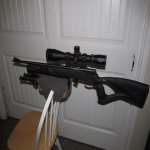I'd argue it's still entirely (supported) positional and improvised field PRECISION shooting. It's all about building a stable enough position to make a precision shot on a smallish target (generally at range). The "race-gun" type matches (PRS, NRL) have pretty much evolved to be a variation on "how well can you shoot a heavy gun off a Gamechanger bag" for a few reasons. Firstly, it's much easier/accessible to run matches on "square" ranges and therefore you end up with some kind of barricade to simulate something you might end up shooting off in "the field". With that being the case, and par times being short, the most effective way to address that is basically to shoot off a heavy support bag with a balanced, heavy rifle. All this has come to pass because there is no disadvantage to having a really heavy setup for these kind of matches being that you don't move far between stages and there is no "time hack" to make. Most of this wouldn't be necessary to hit, say man size/full-size IPSC targets but the targets are generally closer to 2 moa. At what range does it become impractical to be engaging targets un-supported?
Again though, this (PRS/NRL) is a shooting discipline and not some kind of simulation of "fighting with a precision rifle". There are matches that are closer to that, generally billed as "sniper matches" (think Mammoth, Sniper's Unknown, Bushnell series, etc) which require a more "practical" rifle and setup being that you are covering distance under time constraints. The shooting skills between the different styles of matches transfer, you just have to adjust your expectations with regards to how tight and how fast you can shoot going from say a heavy Gamechanger and 20lbs+ rifle to field obstacles, a lightweight support bag/rear bag and a more reasonable (16ish lbs) rifle.
The best answer, if you think the MDs of PRS matches need to challenge the lack of un-supported shooting, is to run your own match(es) with stages and targets that you think best represent how the shooting style should be. Personally, field matches are my preference but I can't host them at my range (the layout is not conducive to it) so I run more typical PRS-type matches but with some pistol components and the occasional off-hand shot thrown in as I believe both those skills to be important. Other MDs do as they see fit.












































































